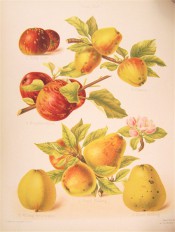Malus domestica ‘Wilding Bitter-sweet’
Macarthur’s ‘Loseby’s Bitter-sweet’ may be similar to the apple described here ‘Wilding Bitter-sweet’. I have found no specific reference to the former.
Fruit; roundish ovate to conical, ribbed. Skin; pale yellow, tinged with green, strewn with russet dots. flesh; white and tender. Juice moderate in quantity, a deep amber colour and of a vapid, bitter-sweet taste. It makes a highly coloured, sweet cider. [HP pl.XLV/1878].
Horticultural & Botanical History
A popular old cider apple, the origin of which is unknown. Produces a hardy, free-growing tree that bears well. [HP].
History at Camden Park
Listed in the 1845, 1850 and 1857 catalogues under Cyder Apples, ‘The Best Known in Devonshire’ [Apple no.48/1845].
Notes
The identification of this apple as ‘Wilding Bitter-sweet’ is problematic. The word ‘Wilding’ as applied to fruit means seed-grown when the parentage is uncertain. In the 17th century in England an apple called ‘Royal Wilding’ achieved some fame in the cider-growing areas of Devonshire. [Batty Langley - Pomona or the Fruit Garden Illustrated p.135/1729]. ‘Royal Wilding’ is used here only as an illustration of bitter-sweet cider apples. All the apples in the figure are cider apples, including ‘Kingston Black’, which see.
Published Apr 16, 2010 - 03:03 PM | Last updated Jul 25, 2011 - 03:19 PM

Apple ‘Wilding Bitter-sweet’ | HP pl.45/1878 - Wilding bitter-sweet is the apple at bottom left | RBGS
| Family | Rosaceae |
|---|---|
| Category | |
| Region of origin | Garden origin, probably England |
| Synonyms | |
| Common Name | Apple, Cider apple |
| Name in the Camden Park Record |
Loseby’s Bitter-sweet |
| Confidence level | low |

